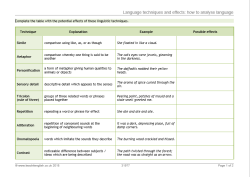Language techniques and effects: how to analyse
A detailed glossary-style resource to support GCSE English Language and GCSE English Literature students in their analysis of a range of literary and language techniques used by fiction and non-fiction writers. Students consider the possible effects of each of the techniques in terms of engaging the reader’s attention.
The teaching resource includes definitions of a range of literary devices to help English students when analysing a piece of writing or a literary work, including:
- metaphor
- simile
- personification (giving non-human or inanimate objects human characteristics)
- sensory details
- alliteration (repetition of consonant sounds)
- onomatopoeia.
There are accessible explanations of each of the nine literary techniques, with example quotations, and students are encouraged to make notes on the possible effects of the techniques in the reader’s mind.
There are also explanations of ten language features and language devices including:
- contrast
- repetition
- rhetorical questions
- emotive language
- word play
- sentence structure
- exaggeration (hyperbole)
- noticeable punctuation (such as ellipsis)
- powerful vocabulary
- tricolon (the rule of three).
Example devices from the resource:
|
Informal language |
casual, relaxed language e.g. slang, dialect and colloquialisms |
‘mate’, ‘aint’ and ‘nowt’ |
|
Alliteration |
repetition of consonant sounds at the beginning of neighbouring words |
It was a dark, depressing place, full of damp corners. |
|
Powerful vocabulary |
powerful or unusual verbs, adverbs, nouns or adjectives to describe actions or things. |
He charged ferociously into the pitch-black room. |
All reviews
Have you used this resource?
Review this resource30/11/2021
18/02/2021
13/02/2021
25/10/2020
16/04/2020
06/03/2020
05/02/2020
09/01/2020
08/01/2020
14/09/2019

